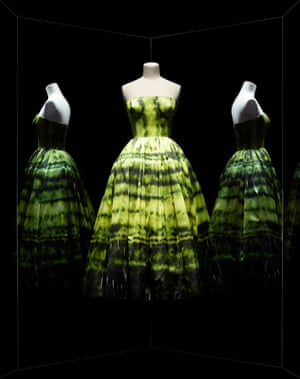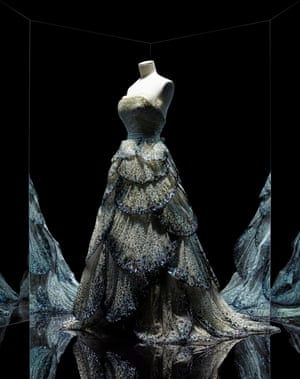Major Paris exhibition celebrates 70 years of Dior fashions
Hannah Marriott
Christian Dior: Designer of Dreams also shows off the work of his successors such as John Galliano and Maria Grazia Chiuri.
The golden age of haute couture may be decades past, but – thanks to the success of shows such as Alexander McQueen: Savage Beauty – we are now living in the golden age of the blockbuster fashion exhibition. Even in that context, it is unusual to see a show of such ambition as the 32,000 sq ft homage to France’s best-known couturier – Christian Dior: Designer of Dreams – which opens at the Musée des Arts Décoratifs in Paris on Wednesday.
The exhibition marks 70 years of the house of Dior and begins simply with a classic gown from 1947. Wasp-waisted with a full, pleated skirt, in so-called “satan red”, it stands out like a traffic light against the gallery’s black lacquered walls. This is Dior’s “New Look” – the silhouette that brought the designer instant fame and ushered in a new, post-war ideal of hourglass femininity.
“After the New Look the house of Dior became visited by tourists like a monument,” says one of the show’s curators, Florence Müller. “It also represented the rebuilding of Paris as a place to see fashion after the war – Dior was an ambassador for that.” Certainly, there is a sense of deification in the opening rooms, where a long, dark corridor is dramatically inlaid with spotlit perspex boxes containing mementoes from the designer’s early life – a tiny pack of cards; his “lucky” gold star – like the relics of a secular saint.
The rest of the show is thematic, intermingling Christian Dior’s creations with the classical busts, Renaissance paintings and surrealist sculptures that inspired them, and with designs by the creative directors who followed after his death in 1957: Yves Saint Laurent, Marc Bohan, Gianfranco Ferré, John Galliano, Raf Simons and the current, first female, holder of the post, Maria Grazia Chiuri.
The show’s use of colour is staggering: one long “Colourama” display features shoes, bags and perfume bottles arranged chromatically – an orange-hued backless dress by Raf Simons beside a clementine-coloured mohair dress-coat by John Galliano, running on and on in tiny increments from mustard to zingy yellow to cream to dove grey to teal to ballet slipper pink to cream to baby blue to lilac to rich purple and burgundy. Later, in a muted, wood-panelled white and grey neoclassical drawing room, there are frothy corseted dresses in Versailles hues: pale pinks, soft blues.

One of the Dior robes in the exhibition. Photograph: Musée des Arts Décoratifs
Another room examines the inspiration Dior drew from gardens – a haute couture minidress covered in little green sprigs introduces an unlikely AstroTurf-meets-cocktail hour moment – while a Monet iris painting hangs from the wall and, overhead, the ceiling is blanketed in thousands of tendrils and vines made from delicate white paper.
The second half of the show brings out the big guns, starting with the white “bar” jacket, with its padded hips, styled with a full black skirt and a basket-style hat, an outfit immortalised in so many fashion history books. After that there are rows of triple-height glass display cases filled with Dior’s superlative, precise grey suiting, and a long, narrow brightly lit room packed with the original toiles of hundreds of sculptural creations, which appear to float like ghosts into infinity owing to the mirrored ceiling. Upon reaching the large final gallery – the “Dior ballroom” – where a shimmering projection of stars cascades over gowns such as Elizabeth Taylor’s 1961 Academy Awards dress and gold Galliano haute couture, visitors with only a passing interest in fashion may find themselves running out of superlatives.

An evening gown from the late 1940s. Photograph: Musée des Arts Décoratifs
There are little threads here that may surprise even the most dedicated Dior heads. Early on, one room represents the influential crew Dior ran with in the 1920s, including Salvador Dali, Man Ray, Calder and Giacometti; Ray’s Perpetual Motive, in which an eye is attached to the pendulum of a metronome, and Dali’s Retrospective Bust of a Woman, which features an inkwell and a baguette balancing on a woman’s head, are on display. In another gallery we read letters between Dior and his father touching on the little-known story of his sister, Catherine, who was part of the French resistance during the second world war, and was rescued from a concentration camp.
The main takeaway, though, is pure sensory overload, an excess of pattern and colour that will have visitors ignoring the polite little captions explaining which of the dresses are by Dior himself and which are by Raf Simons or John Galliano. Galliano’s fantastical creations often steal the show: a coat-gown decorated with Hokusai’s Great Wave and a full-length python dress worn with an ancient Egyptian death mask are among the stand-out pieces. Reminding viewers of Galliano’s technical brilliance – and squishing his work in with that of the revered master – is a sleight of hand that helps the exhibition to gloss over one of the house’s biggest controversies; Galliano’s departure in disgrace in 2011.
Galliano is not the only creative director to have struggled with the pressures of leading such a revered fashion house. Raf Simons spoke of long hours and stress when he left in 2015; Maria Grazia Chiuri has remained upbeat and philosophical when talking about her role, but has met with mixed reviews from critics expecting not just attractive gowns but era-defining surprises.
Grazia Chiuri’s haute couture show took place on Monday in the searing heat outside in the garden of Paris’s Hôtel des Invalides. Having made headlines with her debut collection – which included feminist slogan T-shirts – this time her empowering manifesto was less explicit and more thematic, nodding to female explorers. One shearling jumpsuit looked like a haute take on Amelia Earhart’s aesthetic, while a series of grey suits echoed Christian Dior’s famous tailoring – currently hanging in a museum just a few kilometres across the Seine – almost exactly.










